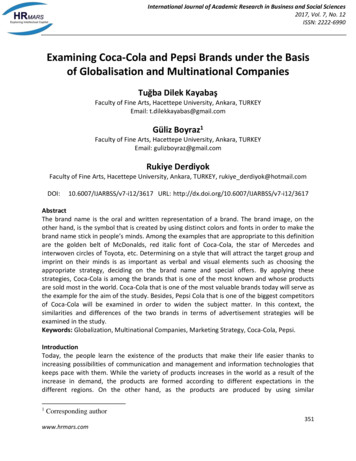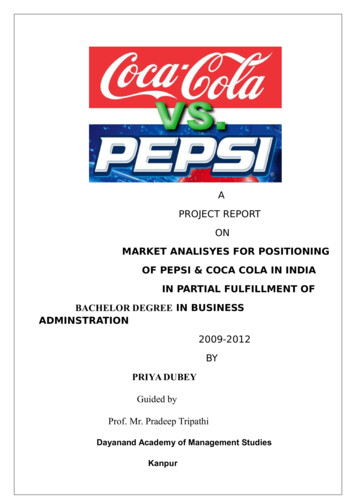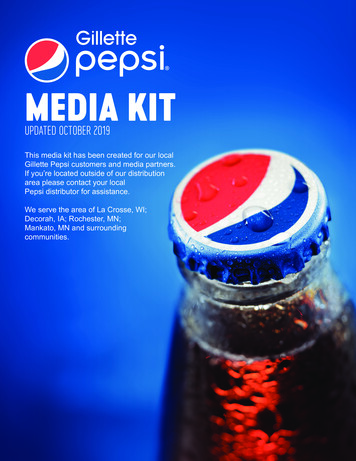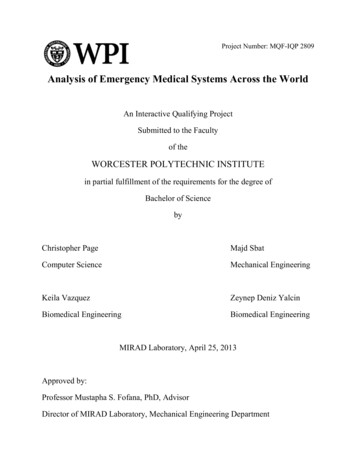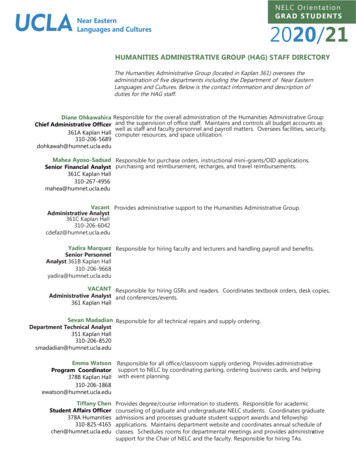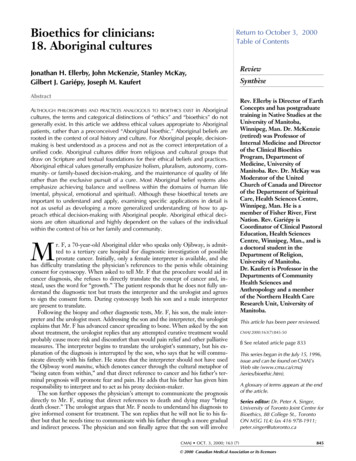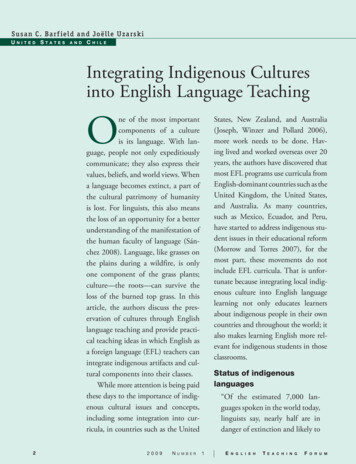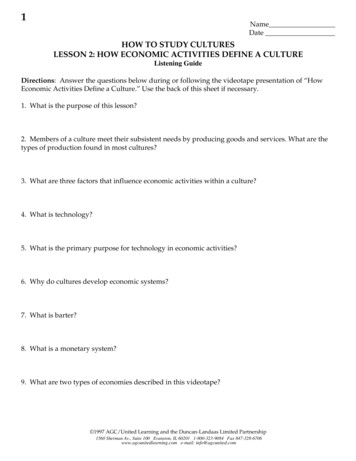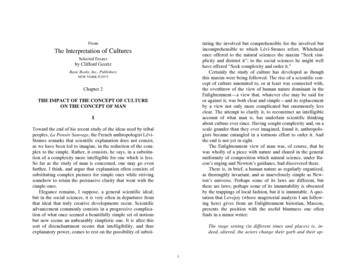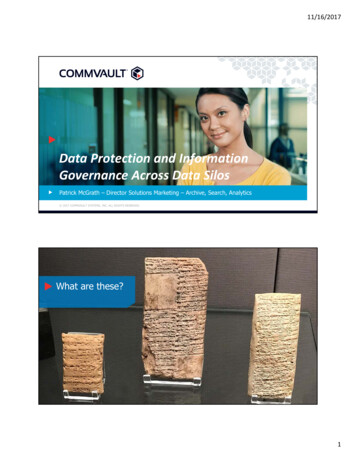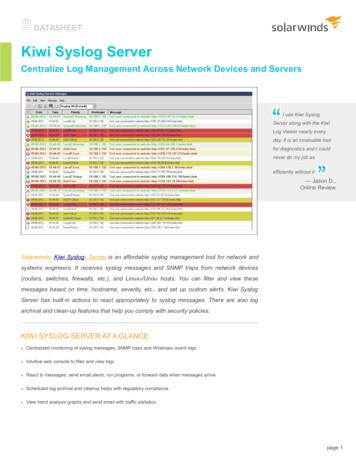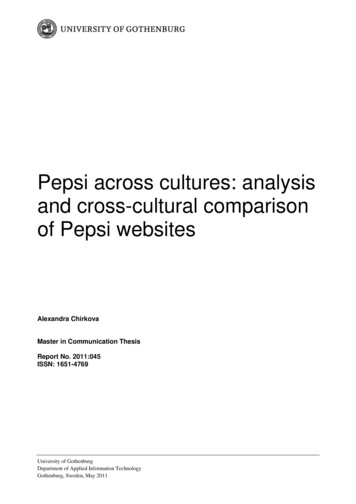
Transcription
Pepsi across cultures: analysisand cross-cultural comparisonof Pepsi websitesAlexandra ChirkovaMaster in Communication ThesisReport No. 2011:045ISSN: 1651-4769University of GothenburgDepartment of Applied Information TechnologyGothenburg, Sweden, May 2011
AbstractNowadays we live in a world where technologies provide great opportunities for crosscultural communication. That’s why it’s really important to be aware of cultural differences andits possible influence on the people’s behavior.This study describes and analyzes the influence of culture on web design and marketingstrategies, with special focus on analysis and comparison of Pepsi’s websites as an instrument ofcommunication with the worldwide audience. The main purpose of the study is to try to throwlight on the issues related to cultural adaptation of marketing strategies when doing businessacross cultural borders.Combination of methods, such as literature study, qualitative and quantitative analysis ofwebsites allows seeing correlations between characteristics of cultures and web design indifferent countries.Results show that there are differences in web design among cultures, which can beexplained by cultural traits and characteristics of the society, such aspects as presence of people,their age and genders, marketing campaigns in focus, symmetry in layout, representedinformation, usage of effects and link to historical information.However, it also showed that there are many exceptions which cannot be really explainedfrom cultural perspective. Company’s choice concerning web design can be influenced bycultures but at the same time there are many different issues influencing on decision-making likemarketing strategy and politics.Keywords: culture, marketing, website, web design2
1.Introduction . 42.Purpose . 63.Methodology. 73.1.3.2.3.3.4.Literature study . 7Analysis of Pepsi websites . 7Limitations . 8Literature study . 104.1. The Internet as a marketing tool.104.2. Pepsi Company.114.3. Culture, Marketing and the Internet .134.3.1.Geert Hofstede . 144.3.2.Edward T. Hall . 164.3.3.Current researches in the area of culture and web design . 165.Results . 205.1. General structure of Pepsi web sites .205.2. People: presence and number of people .205.2.1.People: Gender . 225.2.2.People: Age . 235.3. Marketing campaigns and competitions .255.4. Symmetry .265.5. Represented information .275.6. Effects .285.7. History .305.8. Comments on the exceptions .316. Discussion . 327. Conclusions . 368. Ideas for further research. 379. References . 383
1. IntroductionNowadays we live in a world where processes of globalization flow deeply in our life. Inthe beginning it was mostly about business and financial fields, but now the world is one hugeglobal network. People can easily travel from one part of the world to another. We haveinternational market place. Internet is connecting continents and countries, growing crosscultural contacts. Of course there is an influence of globalization on people’s behavior andattitudes. There is a tendency to unification and accommodation. There is some kind oftransformations and interrelation of cultures. At the same time, we become more and more awareof differences between cultures.If a company wants to operate on the global market, it should be aware of possibledifferences in perception of potential clients and business partners that can influence on successof itself in general and purchasing of the product in particular. Can this awareness influencecompany’s marketing strategy, and if yes, to what extent? The company decides by itself – forsome organizations the decision of “to be the same everywhere” is the main strategy, e.g. IKEA.Accommodating to customers is important with using marketing tools (especially PR andadvertisement instruments). In other words, marketing tools are providers in communicationbetween the company and their present or potential customers. An interesting issue is to analyzehow companies adjust their communication to different target groups determined by cultures.The Internet plays an essential role in marketing nowadays. The Internet providescompanies with a lot of opportunities in terms of communication with customers. Differentsocial networks, chats, forums, blogs and so on, give the ability to talk, listen, observe yourcustomers and people at all. It is not uncommon with some advertisements on Facebook, RussianVkontakte.ru, Swedish mötesplatsen.se, etc. The companies have also their own web-sites tosend the messages; to show themselves in a way they want it to be; to construct communication.These great opportunities enclose risks at the same time, i.e. everything is extremely open toeveryone; the speed of information spreading is incredibly fast; and people have a tendency tofollow the opinions, which is not always objective.One of these twofold issues concerning the Internet lies down on the intercultural field.On the one hand such trend as globalization makes things easier to understand. On the other hand– we should be always aware of cultural differences among countries and even within oneculture. Sometimes companies don’t have an office in one country. It’s pretty much enough tooperate just via a web site. Since web site is a “face” of the company, it should be easily4
understandable and commonly accessible to the majority of visitors – potential customers. It’snot a secret that marketers and designers have their own sense of culture. However differentcountries have their own specific communication traits, which are of course influencing on aperception of sending messages. That’s why the question whether it is necessary to adapt or notto adapt web-sites to a host-country arises.This study focuses on analysis and comparison of Pepsi’s websites as an instrument ofcommunication with the worldwide audience. As a theoretical framework for analysis are takenworks of Hofstede and Hall. The paper will analyze possible cultural influences on Pepsi webdesign and representing of information in the respect of international business.5
2. PurposeThe purpose of this work is to describe and analyze the influence of culture on web designand content of the web pages. The study focuses on one international company, PepsiCo, andone of the company’s most popular products – Pepsi. On the basis on the analysis of PepsiCoexperience, this study tries to throw light on the issues related to cultural adaptation of marketingstrategies when doing business across cultural borders. More specifically, in this study the focuslies on the analysis of marketing via the Internet.This thesis touches one side of possible cultural reflection in communication in a businesssphere and marketing – web design. The research questions of this study are presented below:1. What is a general structure of Pepsi websites?2. Are there any elements that can categorize the websites?3. Are there any differences and /or similarities between the web pages for Pepsi indifferent countries? If yes, which? How are these differences related to thecultures of these countries?4. What conclusions can we draw based on the analysis in this study concerning theimpact of culture on web design?6
3. MethodologyA combination of a literature study with quantitative and qualitative analysis of websitesis used in this study.3.1.Literature studyThe literature study presents a brief overview of research on culture and taxonomies ofcultural patterns, current research on marketing as well as culture influences and web design. Ashort overview of research of Geert Hofstede and Edward T. Hall is provided as their researchwill partially be used in this work. Scientific databases such as ScienceDirect, Emerald,Gothenburg University database (GUNDA), and Goggle Scholar search have been usedsearching for articles related to web design and culture. Combination of the issues from differentstudies provides a reliable platform for the research and discussion.A combination of quantitative and qualitative analysis is used to the analysis of Pepsiwebsites. Below, I provide an overview of the research procedure.3.2.Analysis of Pepsi websitesQuantitative analysis is called on to present an objective statistical picture of the elementsused on the websites. The Pepsi’s websites (39 in total) are listed and grouped into six groups bya geographical belonging of the countries: North America, Latin America, Europe, Middle East,Africa and Asia Pacific (Appendix 1). Some countries have their one region website likewww.pepsiarabia.com for Israel, Jordan Kuwait, Lebanon, Saudi Arabia, Syria, United ArabEmirates, Egypt and Nigeria. The countries which haven’t got own Pepsi website are redirectingto the websites of other neighboring countries.The websites are grouped according to the regions and countries and presented in tablestogether with Hofstede’s indexes for each country. It’s important to mention here that allcalculations and observations are made on the main pages of websites. Using the literatureanalysis, the analysis of the features of the web pages was conducted to see if PepsiCo adaptstheir web pages to the cultures of its potential consumers. The following features of the websiteshave been analyzed:1. presence of people on the websites and their demographics (gender and age),focus on product;2. marketing campaigns;3. symmetry;7
4. represented information;5. effects (animation, video and sound);6. link to historical information.Collecting these data provides the foundation for the further correlation analysis betweenwebsites elements (and their combinations) and cultural dimensions. Analysis of all elements aregathered in tables and sorted by value of indexes from Hofstede’s study. For each dimension isfound average value among all countries which is taken as a point for dividing countries fromlowest values (marks with light shadow) to highest (marks with dark shadow) to see correlationsand reflections of culture dimensions if any.Qualitative analysis is used to illustrate the findings from the qualitative analysis and tomake as complete picture as possible of cultural influences on Pepsi web design.3.3.LimitationsAll these methods, in spite of the fact that they cover a number of issues, cannot showthe whole picture. These tools don’t give the inside view on such problems as, for example, theways how managers make decisions concerning web design and even marketing campaigns indifferent cultures. Marketing process is usually very closed and invisible to the public, no matterhow open the company is. Unfortunately, in business sphere and particularly in marketing th
This study describes and analyzes the influence of culture on web design and marketing strategies, with special focus on analysis and comparison of Pepsi’s websites as an instrument of communication with the worldwide audience. The main purpose of the study is to try to throw
